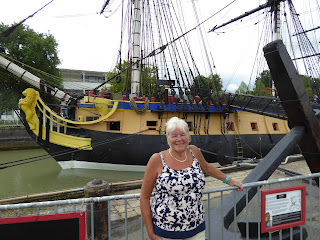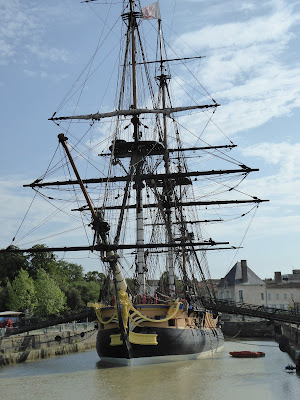Mile:
16482 Daily: 000
Meteo: Hot and sunny. Then
rain then sun.
After breakfast and a couple
of long hot showers we are ready for the short walk again to L’Hermione. The
lady at the ticket office has a badge which proudly proclaims she speaks
English but it’s not sufficient to answer my questions about the various other
museums we wish to visit today. We buy tickets into the display area and
workshops for the ship as well as the naval museum housed at the head of the
dock.
 |
Jackie ringing Blighty before joining the crew. |
Rochefort since earliest times
has been associated with French Naval architecture. The dock into which
L’Hermione now floats was the first stone dock of its kind in the world. Repairs
before then were carried out on all ships by laying them on their side, working
on the up side then flipping them when complete. Then came the digging of a
large hole or grave to float the boat into, a dam was constructed behind it and
the water pumped out. The French tried this method here on the Charente River
but the banks were too soft and kept collapsing. French ingenuity decreed that
they drive down to bedrock and install pilings and build stone walls up from
there. Add a couple of gates at the end and you have the world’s first dry/wet
dock. They even added a roof over everything so that work could continue in all
weathers.
I thought it was us English. Wrong again.
The weather was very grey and overcast and we were due for some pretty heavy rain. After passing through the ticket office you entered an interpretation centre taking you through the conceptual idea and how the work was started and completed. It taking 12 years. It must be remembered that no plans existed for the Hermione and so much details were taken from models, still in existence and what information was available from historical records here and strangely in the USA. Ancient skills had to be relearnt, honed and applied. Craftsmen from all over would attend and work for weeks and months. This was all apply seen from the 'workshops' now on display as we passed down the covered walkways in a double linear approach to the ship itself.
Carpentry, rope making, smithy, sail making, canons and various armaments displays were all represented. By the time we had wandered through the various informative TV monitors, display boards and video presentations the rain, which had been lashing down had now stopped. The sun was out. Just in time for Mike and Jackie to be piped aboard.
Upper deck. There was also a lower gun deck come living quarters. |















